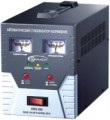Output voltage accuracy (±)
The largest deviation from the nominal output voltage (230 V or 400 V, depending on the number of phases), which the regulator allows when operating in the normal input voltage range (see above). The smaller this deviation, the more efficiently the device works, the more accurately it adapts to “changes in the situation” and the less voltage fluctuations the connected load is exposed to.
When choosing for this parameter, it is worth considering first of all how demanding the connected devices are for voltage stability. On the one hand, high stability is good for any device, on the other hand, it usually means a high price. Accordingly, it usually does not make sense to buy an advanced stabilizer for an unpretentious load like light bulbs and heaters, but for sensitive devices like audio systems or computers, it can be very useful.
Protection
-
From overheating. Protection that prevents the critical temperature rise of individual components of the stabilizer - for example, in case of overload, short circuit or failure in the cooling system. When a certain temperature value is exceeded, it turns off the device in order to avoid breakdowns and fires. Such systems are especially important for semiconductor types of stabilizers - thyristor and
triac(see above). And in some models, this function can be supplemented by a temperature increase signal - it works at a temperature close to critical.
-
From high-frequency interference. This protection dampens incoming high-frequency interference, preventing them from affecting the operation of devices connected to the stabilizer. Such interference can occur, for example, from electric motors, welding machines, etc. So, in audio systems, high-frequency distortion causes an unpleasant background from the speakers. RFI protection filters out these distortions, providing a smooth sine wave output.
-
Against short circuit. A system that protects the stabilizer in the event of short circuits in the connected load. A short circuit is a situation when the resistance in the circuit becomes close to zero; this leads to a sharp increase in current strength, overloads the power grid and the stabilizer itself, and also creates a ri
...sk of breakdown or even fire. In order to avoid unpleasant consequences, appropriate protection is provided: it disconnects the load in case of a significant excess of the current in it. This feature is almost mandatory in modern stabilizers.
- From overload. Safety system in case of stabilizer overload - that is, a situation when the total power of the connected load becomes greater than the corresponding indicators of the device itself (see "Power"). The reason for this situation may be, for example, the inclusion of an additional consumer or a change in the operating mode of one of the existing ones. Unlike the short circuit described above, when overloaded, all electrical appliances work normally, the stabilizer itself is abnormal, which can lead to its failure or even fire. To avoid this, overload protection is applied. Its specific implementation may be different. In some models, the load is turned off immediately, in others - after a certain time after the warning signal, which gives the user the opportunity to reduce power consumption and avoid system tripping.
- From over / under voltage. A system that protects the device from too low or too high input voltage. A significant overshoot of the input voltage range (see above) is dangerous not only by the risk of damage to the stabilizer itself: under such conditions, the device’s capabilities are not enough to fully protect the connected load, which can result in trouble for it. And this function prevents such consequences: if the input voltage goes beyond the permissible values (they may be wider than the operating values, see “Input voltage range”), the stabilizer is disconnected from the network. At the same time, some of its functions may remain operational - for example, a voltmeter that allows you to assess the "state of affairs" in the network at the input. And in some models there is a function to automatically turn on when the voltage returns to operating limits.
